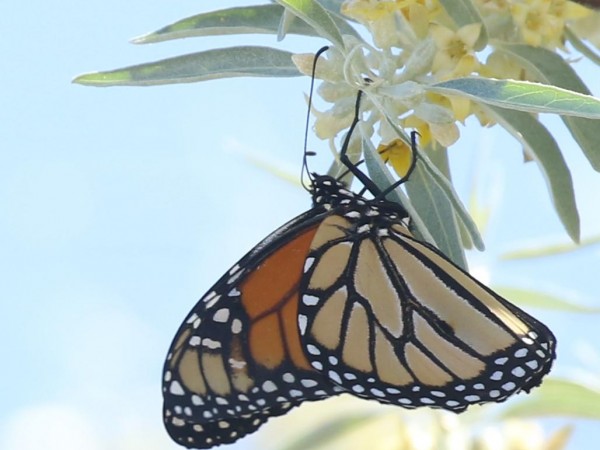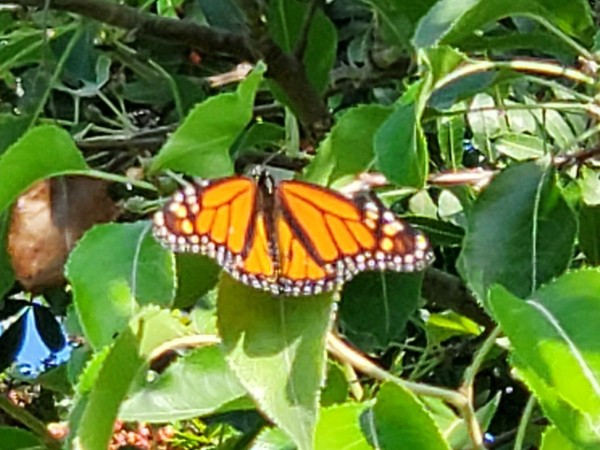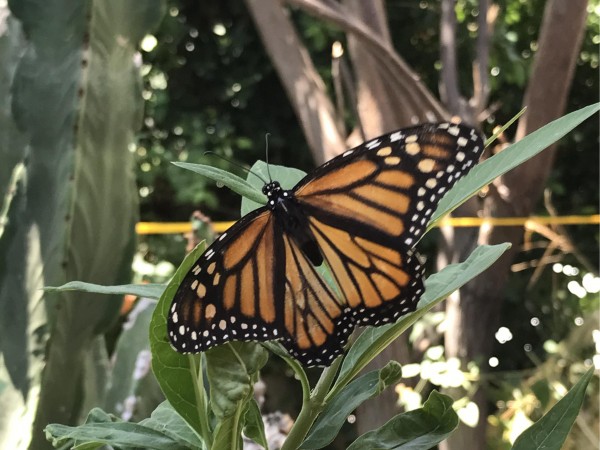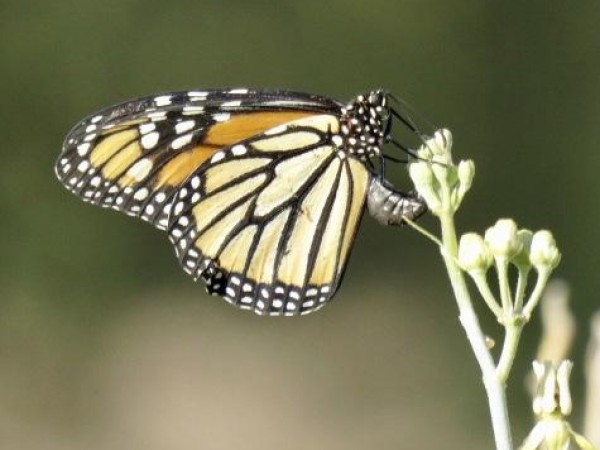Letter from Gail Morris: Western Monarch Spring Report #14
Published: 06/02/2021
Dear Western Monarch Friends,
Monarchs are still journeying north as they near the “finish line” to their summer breeding grounds. An exciting find – monarchs are now documented in Northern California near the Oregon border for the first time this year! Dr. David James shares his update from his annual field trip to the Trinity River searching for monarchs, too. A new sighting in Oregon appears as well – monarchs are still on the move!
Oregon
Lara spotted her first monarch of the season on May 27 in Portland. “On our chard plants, which have been left to grow since last year and are now flowering.”
We are all looking forward to the first photo documentation of monarchs entering the state of Oregon, so be sure to send your photos in!
California
An important milestone on May 28 when Jim spotted two monarchs near the Oregon border! “At Shasta Valley State Wildlife Area.” (Be sure to read about more in Dr. David James’ report below.)
Cindy saw one monarch in Valley Center on the same day, “My first female monarch sighting in garden! Lots of milkweed options. Seems to be interested in the buddleia and oak trees.”
Joey saw one monarch in West Covina on May 29. “It was near a tree and seemed to be resting.”
Polly in Thousand Oaks found one monarch on May 30. “One adult monarch observed going between 2 milkweed plants.”
Monarchs are still present in the desert regions of California as well. Cord in Palm Springs still has one monarch despite soaring temperatures. “The monarch in this picture found one of my milkweed plants and as I watched it laid nine eggs...”
Arizona
In most years monarchs leave the lower deserts by mid-May as the temperatures climb into the low 100’s. But this year has been cooler than usual the last ten days and a few monarchs are still around.
On May 24 Patty spotted one monarch in her yard in Tempe. “Adult female monarch in excellent shape nectaring on Vinca and Gregg's Mistflower in my back yard. I did not see a tag. I first saw her about 6:25 PM. She spent about 15 minutes in my yard before flying off to the East. It was a nice sunny 91 degree day with no wind.”
Michelle was lucky to find one monarch in her yard in Phoenix on May 25 laying eggs on Desert (Rush) Milkweed. “Oviposited on Asclepius [sic] subulata for several minutes.”
Trinity River Field Trip
Every year Dr. David James of Washington State University and his family travel to the Trinity River in Northern California looking for monarchs. These annual hallmarks of the Spring migration season give everyone important data points for comparison over time. Here are his findings from this year’s field trip:
“Since 2012, I have spent Memorial Day weekend along the Trinity River in Northern California, looking for and counting Monarchs. During this family tradition, we have seen and documented the rise and fall of Monarch populations seeing just 10 in 2012, reaching a peak of more than 100 in 2016, falling to 10 in 2017 and 2018. In 2019, 2020 and now this year, no Monarchs were present along the Trinity River during Memorial Day weekend. We also examined more than 1000 milkweed stems and did not find any Monarch eggs or larvae. However, it’s not all bad news! On May 28, two fresh-looking Monarchs were sighted and confirmed with photographs at the Shasta Valley State Wildlife Area at Montague, CA which is just 20 miles from the Oregon border. These were likely migrants and provide some optimism that at least a few monarchs will infiltrate southern Oregon this summer and perhaps some may make it further. There are already unconfirmed reports of single sightings in western Washington and Portland, but we need photos for confirmation. So if you spot a monarch over the next few months in Oregon, Washington or Idaho, please get a photo, however poor! The first two weeks of June, historically has been the period when migrants from California appear in numbers in northern Oregon and southern Washington. So please get out there and keep your eyes open!”
Be sure to send your sighting data and photos to Journey North! Many monarch watchers are eagerly awaiting their arrival.
Send in your reports!
Spring weather is great for a walk so be sure to take your camera or phone along on your neighborhood stroll or hike and tell us what you see. Your reports can help everyone know the “status of the breeding habitat” where you live. Don’t forget to report milkweeds up and, of course, any monarchs you see! Remember, monarchs may lay eggs on milkweed before they flower so other nectar resources are important. They sometimes lay their eggs inside flowers, so look inside for tiny (first instar) caterpillars. A photo from your phone or camera can help us all see the progress early monarchs are now making in the spring migration. Warm weather and southerly winds can help monarchs move into your area! Be sure to watch https://www.windy.com frequently to see when winds favor monarch movement in your area. Where will monarchs fly this week?
Gail Morris is the Coordinator of the Southwest Monarch Study (www.swmonarchs.org), a Monarch Watch Conservation Specialist, and the Vice President of the Monarch Butterfly Fund and the Central Arizona Butterfly Association. The Western Monarch Population News is based on comments provided to Gail Morris. We hope to increase the number of sightings and therefore photos and comments entered into the Journey North. We rely on the volunteers who communicate regularly with Gail and who agree to participate in our effort to increase awareness of the population of western Monarchs. You can reach her at gail@swmonarchs.org.





